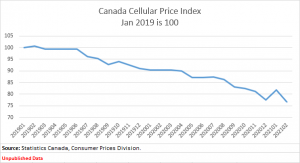Political theatrics
Canada’s Parliamentary Standing Committee on Industry, Science and Technology, better known as “INDU” has released its report “Affordability and Accessibility of Telecommunications Services in Canada: Encouraging Competition to (Finally) Bridge the Digital Divide” [pdf, 3.5 MB].
The 68 page report is largely unintelligible gibberish, representing a complete waste of time for our Parliamentarians, the witnesses and the parties who prepared representations before the Committee. Seven of those pages are completely blank, so a little better than 10% of the report is useful as scratch paper. Not all of the witnesses who appeared are acknowledged in the report, and the list of submissions by parties is incomplete.
I note that the report is not tagged as a preliminary draft. It should be. The release of this report, in this condition, should not be considered one of the prouder moments for the INDU Committee.
Recommendation 3 is indecipherable:
That the Canadian Radio-television and Telecommunications Commission establish an affordability standard for telecommunications services across Canada after consulting with various stakeholders, taking into account an affordability standard for wholesale Internet rates ensuring equitable treatment of network owners and virtual operators in order to significantly reduce the cost of bandwidth among providers, thereby encouraging more competition and reducing the price of consumer packages, and that it issue its decision within a year.
What does it mean to establish an “affordability standard” that takes into account a wholesale affordability standard?
Recommendation number 4 is also a beauty:
That the Government of Canada increase service costs by 50 cents for Canadians who are willing and able to afford the incurred cost in order to come to the aid of neighbors that can not afford high prices.
Isn’t that what we usually consider to be the role of government social benefits?
Recommendations 5 and 6 show that the committee clearly didn’t understand how government has completely failed lower income households in developing affordable connectivity solutions.
Recommendation 5
That the Government of Canada create a benefit for large band services until the end of the pandemic for low-income Canadians, seniors or Canadians who have lost their jobs during the pandemic.Recommendation 6
That the Government of Canada change some of the parameters for the Connecting Families program to improve accessibility by, for example:
- Changing the eligibility criteria and better targeting families to ensure all low-income households have access to it;
- Requiring service providers to participate in the program and funding them directly; and
- Promoting programs more strategically so that more low-income families are aware of them.
Repeat after me: “Connecting Families is a private sector initiative.” And, as I wrote in “The broadband divide’s little secret”, research has shown that low prices aren’t enough to get more people online.
Oh, can someone tell me what the heck are these “large band services” in Recommendation 5?
Recommendation 12 is just plain silly:
That the Government of Canada put in place a variety of means to support improved connectivity in rural and remote areas. For example, it could:
- Provide financial support to help build infrastructure for carriers or service providers who are in areas where it is not economically beneficial for them to build it on their own in order to help reach the objective of providing an appropriate level of service;
- Ensure or promote competition in areas where there is only a small number of providers by allowing resale, allowing access to third parties to then provide services using the facilities of the incumbent
The first part, subsidizing rural builds, is precisely what governments have been doing since what seems like the beginning of time. The second part says the government should allow competition? Hello? Competition is already allowed by the Government of Canada. The CRTC also allows competition. It just doesn’t mandate certain types of competition, although it does mandate others. There is a difference between allowing competition and mandating resale. How could this committee not know the difference?
The report is, or at least should be, an embarrassment to the members of the committee and the staff who supported it. If I marked this as an undergraduate paper, I would assign a failing grade. It’s really not surprising given the political theatrics that took place during meetings seeking evidence for the report. Perhaps the quality of such studies would benefit from INDU Committee actually listening to witnesses and reading submissions to learn about subject areas, rather than trying to score cheap political points through ‘gotcha’ style cross-examination.
As it stands, the report is unworthy of the seal of the House of Commons coat of arms that adorns its cover page. Given the subject matter, “Affordability and Accessibility of Telecommunications Services in Canada”, that’s especially disappointing.

